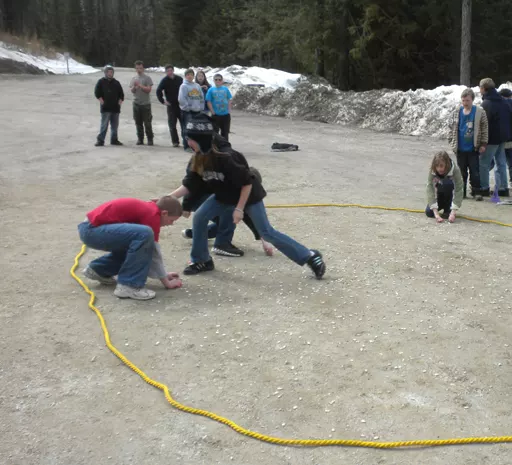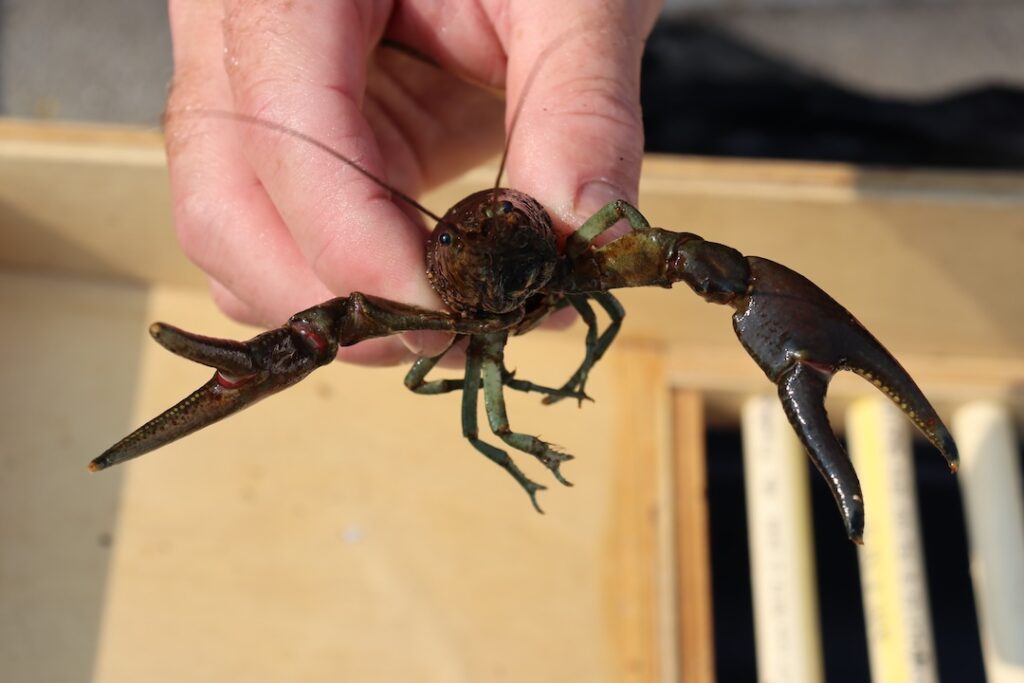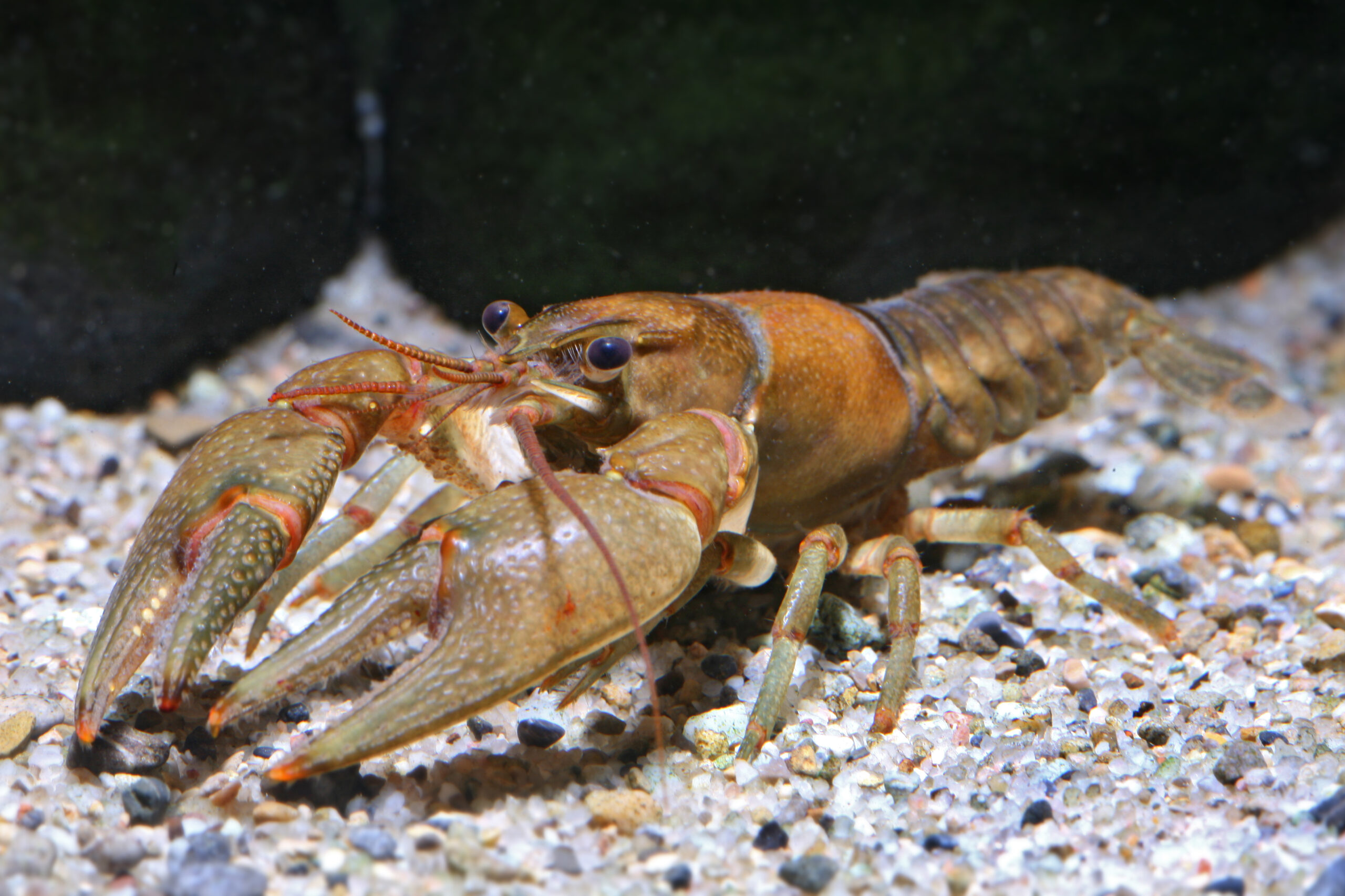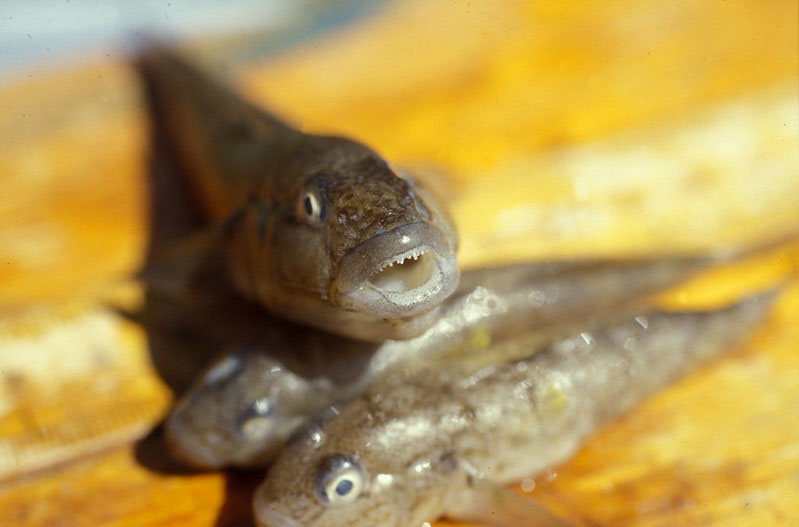Lesson Summary
In this lesson, students model impacts of invasive species by playing an engaging game designed to help them think critically about native and invasive species and their roles in freshwater ecosystems.
Through kinesthetic learning, students experience how aggressive exotic species can over consume a wide range of resources to expand their territory and compete in a non-native habitat.
In a race for survival, each team represents a different species found near you. Team members take turns in the “lake” (game area) to gather food resources in hopes that their species will survive, while struggling against competition from other species and environmental stressors.
Multiple rounds are played and graphed to illustrate fluctuations in species strength due to stress factors. The game can be played with groups as small as eight students, or as many as 60.
Photo Credit: National Park Service

Objectives
Students will accomplish the following goals upon completing this lesson:
- increase understanding of native and invasive crayfish and their roles in freshwater ecosystems,
- think critically about how invasive crayfish and other invasive species can be a threat to a variety of native species as well as biodiversity,
- increase skills with analyzing and visualizing data they have collected.
Students will meet the following objectives upon completing this lesson:
- participate in an educational simulation and demonstrate their understanding of the roles of invasive crayfish species in freshwater ecosystems,
- analyze data collected as a class and create visualizations with it,
- express orally and/or in writing what they have learned about native and invasive crayfish and their impacts on freshwater ecosystems.

Lesson Alignment
Next Generation Science Standards: Performance Expectations: MS-LS2-1, MS-LS2-4.
Next Generation Science Standards: Building Toward: HS-LS2-1, HS-LS2-2, HS-LS2-6.
Next Generation Science Standards: Crosscutting Concepts Patterns, Cause and Effect, Stability and Change, Systems and Systems Models.
Next Genertion Science Standards: Science & Engineering Practices Analyzing and Interpreting Data, Constructing Explanations and Designing Solultions, Develping and Using Models, Obtaining, Evaluating and Communicating Information.
Next Generation Science Standards Core and Component Ideas in Life Science: LS2, LS2.A, LS2.C
Next Generation Science Standards Core and Component Ideas in Earth and Space Science: ESS2, ESS3.C
Common Core State Standards
Math Standards: Measurement & Data, Represent and interpret data, Statistics and Probablity, Summarize and describe distributions.
Speaking and Listening Standards for Gr. 6- S1, S4 (Similar standards exist for Gr.4-5 and 7-12)
Materials
Access printed copies or electronic versions of lesson materials below.
- One-gallon bag of three different dried beans; we suggest pinto bean, red kidney bean, and lima beans
- 60-foot (or longer) section of rope
- Four signs that stand up on poles or easels (signs you can lie on the ground would also work) showing different species: a native crayfish, two other native species, such as northern leopard frog and cutthroat trout, and one invasive crayfish species
- Blue, brown, red, and purple washable markers
- Masking tape
- Four clear containers (plastic or strong glass jars, for collecting beans)
- Easel
- Timer (cell phones work well, as do egg timers)
Background Information for Educator
Invasive and Native Crayfish
Graphs
Print 11″x17″ or tape two sheets together
Lake Sturgeon Game Card
Bean Game Card 1
Northern Leopard Frog Game Card
Bean Game Card 2
Devil Crayfish Game Card
Bean Game Card 3
Red Swamp Crayfish Game Card
Bean Game Card 4
Rusty Crayfish Consume Lake Sturgeon Eggs
Web resource
“Stone Soup: Invasive Species and Cartooning”
Web resource
“Design the Ultimate Invader”
Web resource
“Invasive crayfish threaten species in Oregon’s Crater Lake.”
Video Resource
“Crayfish Invasion.”
Video Resource
Invasive Crayfish Collaborative Website
Additional Resources
Investigating Crayfish and Freshwater Ecosystems
Full Curriculum
Time Required
Completion of this lesson may require one class period to complete.
Activity Set-Up
Prepare a large play area with at least 400 square feet (37 sq. m) of packed dirt (ideally free of weeds): school playground, baseball diamond, etc.; very thin grass will also work. The ground needs to camouflage dried beans, but not completely hide them. Set out the rope on the ground and form into a 20-foot (6 m) diameter circle (or larger) across the play area.
Allow for plenty of space outside the main play area circle, too, for a total diameter of 100 feet or more (40 feet beyond each side of the circle). This provides enough space around the circle so that, later in the game, groups lined up can get pushed away from the circle in 5-foot increments. This simulates increasing stress as it becomes more challenging to find food.
Set up the easel and tape a graph to the front (or draw one).
Take the one-gallon bag of bean mixture and evenly distribute beansinside the rope circle.
Set out “sign-a-cades”—signs held up vertically—as shown in lesson pdf as triangles, one for each of the four species in the game. (See the signs at the end of the lesson.) Signs should be about 5 feet (1.5 m) from the rope circle. (Simple signs with weights such as rocks so they don’t blow away will also work).
Photo credit: Minnesota AIS Research Center.jpg

Optional: Optional: Learn more about native and invasive crayfish and/or review the information presented in the sourceslisted in the More Resources/References section at end of the lesson to prepare to answer student questions.
Lesson
Engage
- Gather students outside of the game area. Tell them they will be playing the Competing Crayfish Game in teams representing different species. They can be the species below, listed with the type of bean(s) they can eat, or other species that you choose:
- Lake sturgeon (native–red kidney beans)
- Northern leopard frog (native–pinto beans)
- Devil crayfish (native–all 3 types of beans: lima, pinto, and red) Note: Studies found that rusty crayfish actually consume lake sturgeon eggs in spawning areas, so this could be a good story to tie to the activity at this point, if time allows, or during the Explain portion of the lesson, below. We have included a link in materials to support this.
- An invasive crayfish species that is a problem in your area: red swamp crayfish, rusty crayfish, etc. (all three types of beans: lima, pinto, and red)
- Discuss which species are native to your area and which are invasive. Ask the students what those terms mean. Explain that the goal of the game is to survive: not only as an individual, but also as a species/team.
Explore
- Divide students into four groups (or ask them to quickly count off “1-2-3-4” to divide them). Assign each group to a different species. Ask each group to stand in a straight line behind the sign for their species.
- Show the student teams which of the three beans their team will “eat.” Tell them they can only pick up that bean type. Other beans will not be counted.
- Play the first round of the game with the three native species after briefly explaining the rules below (the invasive species join in round 2):
- When you say “SPRING—GO!”, the first student from each native species enters the circle to forage for food and picks up ONLY five beans (of the type they eat). Note: Limiting students to five beans each turn allows more of them to participate per round and keeps the energy high.
- The first student runs back to their team and drops the five beans in the team cup.
- The second student in line then entersthe circle to forage and so on. The species should make as many trips as they can until you call “WINTER—STOP!” At that point, students must stand up immediately and move out of the circle. Any beans they have in their hand can be taken back to their cup.
- Students will count how many beanstheir species collected and tell you so the data can be recorded (and later graphed).
- SAFETY: Tell students that they are not to push or shove each other, since this will draw attention from “fishermen.” Anyone seen doing so will be “caught” and removed from the game.
- Round 2
- Tell students that the invasive species will now join the game. The red swamp crayfish (or whateverspecies you choose) are aggressive, voracious eatersthat can each pick up eight beans per player (instead of five). Like the native crayfish species, they are also not picky eaters, so they can eat all three types of beans.
- Record the number of beans collected by each species in a chart that the students can see, similar to the one below. Later the students can record their crayfish data in science notebooks, in a shared spreadsheet, etc.

- Additional rounds
- After the third round, compare the numbers on the chart. Ask students, “What patterns do you notice so far?”
- If any species fails to collect beans during a round, their species becomes extirpated (locally extinct). You may choose to add their numbers to the invasive species astheir bodies are recycled into the environment to become new pike fry.
- Consider adding new rules, one at a time, to simulate different natural phenomena. Discuss with students how they relate to real-world issuesfaced by animals in the wild.
- After the last round, work with students to pick up all the beans. Discuss how they are introduced species that we don’t want to become established.
Game variations include:
- “Habitat Loss”
- Move the signs back 3–5 feet (1–2 meters) for each species that does not meet or exceed the bean count from the previous round. (Don’t tell the students this is your reason; give the reason below.)
- Simulatesreduced ability to accessforaging grounds and stress on species
- May also be due to factorssuch as drought,seasonal lake draining, log jams, etc.
- Climate Change
- Researchers have found that warmer water and air temperatures are allowing red swamp crayfish to produce two broods of eggs per female per season, instead of one for native crayfish.
- After the round starts, allow another player from the team to join the game, and potentially a third and fourth toward the end of the round, to simulate the exponential growth rate that this advantage might give to the invasive crayfish.
- “Stress Death”
- Remove an individual from each species that does not meet or exceed the bean count from the previous round (you may or may not choose to point this reason out to students.)
- Simulates loss of individualsfrom a population due to starvation
- Choose well-behaved individuals or a student who can perform a dramatic death scene
- “Kleptoparasitism”
- The invasive species can take the beans of another species. They must tag the species (GENTLY) and the tagged student must then hand over their beans; after that, they continue collecting their beans.
- This may be done freely or only once per round, depending on the students.
- This simulates the phenomena of kleptoparasitism: when animals steal food from other animals. It is not a common trait in the species used for this game, but is seen in species such as gulls, eagles, foxes, and coyotes.
- Remind students that if they act roughly or throw beans, they will be “caught” and removed.
- Predation on Natives and/or Cannibalism
- Be very careful/selective when using this variation.
- Invasive species can eat one of the natives. They must tag the species(GENTLY) and the tagged student must join the invasive team.
- No more than one player per round per person can be removed. Consider limiting total predation to 1–2 students per round.
- Remind students that anyone acting roughly or throwing beans will be “caught” and removed.
- Population Boom
- Multiple members of the invasive species may enter the circle at the same time.
- Explain that thissimulates a boom in the population of the invasive species.
- Invasive Species Cook-Off
- Help restore balance to the game by assigning a student to be a fisherman who “traps” invasive crayfish.
- If an invasive crayfish player is tagged, they must leave the game. Another player from the invasive team can then join the game, but there is no limit to the number of invasive crayfish that can be tagged per round.
- Additional rule option for the same round or the next one: If a player from the native crayfish team istagged, they must freeze in place. Another player from their team can enter the game and tag the frozen player to release them (to simulate releasing live native crayfish).
- For students that have experience with visual data analysis: Ask students to work with their team (or just a partner) to visually present the data you collected as a class. Or guide them by asking them to think about how the data can be analyzed and how it can be presented visually. Discuss how it can be used to calculate averages, present histograms(bar charts), etc., and have students do the calculations and create the visualizations you discuss.
Explain
- For students that have little to no experience with visual data analysis: Work with students to create bar charts(histograms) to analyze the data. Discuss how this helps visualize any patterns that occur.
- Review the concept of adaptation: developing a trait that helps a plant or animal survive in its environment. What behavioral and/or physical adaptations might crayfish—especially invasive crayfish—have that help them?
- Review the ecological term competition: when different species need the same resource, but there are limited amounts of it (MS-LS2-1). Discuss with students how competition from invasive crayfish impacted the native species—and how they compete in the wild.
- Review the data analysis with the class and close with a discussion about native and invasive crayfish and how they can impact freshwater ecosystems.
Extend
Play the game on another day with more of the in-game variations listed above. Ask students to record and analyze the data with less support from you. Additional variations you might try include:
- “Limited Carrying Capacity”
- Throw out fewer beans during setup OR don’t throw back beans that were used in previous rounds.
- Increases competition and highlightslimited resources caused by climate change, natural disasters, and/or human impact.
- This variation is strongly suggested for middle grade students; it helps meet NGSS DCI MS-LS2-4 (“Construct an argument supported by empirical evidence that changes to physical or biological components of an ecosystem affect populations.”) Students should construct the argument orally and/or in writing.
- “Real-World Connections”
- Allow ALL studentsc to enter the foraging area during each round. This may be used in combination with any other variables listed above.
- To slow them down, introduce the rule that fish, frogs, and crayfish don’t run. To be fish or frogs, they need to keep their feet together and wiggle-hop/swim. Length of time per round can be extended to 30 seconds.
- For larger groups or older students, a longer rope (such as 100-feet) could be used to expand the circle.
- You may need larger buckets for teams to collect their beans.
- Ask studentsto create a written analysis of the game and what it taught them about invasive crayfish species.
- Students can complete the “Invasive Species Project” explained on the handout in this educator’s guide.
- Have students read cartoons about invasive crayfish and/or create their own cartoons. Excellent examples and ideas are listed in the “Stone Soup: Invasive Species and Cartooning” lesson plan found on the Take AIM website available in materials.
- Encourage students to “Design the Ultimate Invader” as explained in a lesson plan from Oregon Sea Grant’s “Menace of the West” website linked in materials.
- Show one or more short video clip(s) about crayfish, such as:
- “Invasive crayfish threaten species in Oregon’s Crater Lake.” Oregon Public Broadcasting (OPB) linked in materials.
- “Crayfish Invasion.” The first part of this Oregon Field Guide episode from OPB linked in materials.
- Invite students to create public service announcement videos about invasive crayfish and ways to keep them from spreading.
Evaluate
- Review student tables of data, as well as data visualizations and/or written analyses.
- Record levels of oral participation and student understanding.
- Ask studentsto reflect on the lesson in writing and/or orally, including about what they learned and what you, as the teacher, might do to improve the lesson next time.
Resources
Expand Knowledge + Skills
- “Invasive Crayfish 101.” Invasive Crayfish Collaborative | LINK
- “Great Lakes Crayfish Regulation.” Invasive Crayfish Collaborative | LINK
- Michigan Invasive Species: Crayfish | LINK
- Callaway, E. “Geneticists Unravel Secrets of Super-Invasive Crayfish.” Scientific American. | LINK
- “Detecting and Monitoring Aquatic Invasive Species.” EPA | LINK
- “How You Can Help.” Stop Aquatic Hitchhikers! | LINK
- USDA Invasive Speciesresources | LINK
Lessons/Activities
- “Land of Many Opportunists.” Activity adapted for thislesson by permission. National Park Service | LINK
- “Stone Soup: Invasive Species and Cartooning.” Jan Eliot | LINK
Education Standards

This lesson is part of a larger curriculum, Investigating Crayfish and Freshwater Ecosystems.




